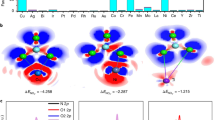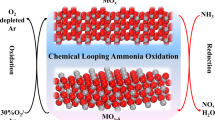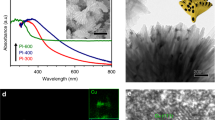Abstract
Alternative routes to the Haber–Bosch process are being sought to electrify ammonia synthesis. Nitric oxide can be electrocatalytically converted into ammonia, but the Faradaic efficiencies and rates of production are currently far below those needed for industrial application. Here we report a rationally designed copper–tin alloy that is highly active in the synthesis of ammonia from nitric oxide. The rate of ammonia production in a flow cell reached 10 mmol cm−2 h−1 with a Faradaic efficiency of >96% at a current density >1,400 mA cm−2, and it remained stable at >600 mA cm−2 with an ammonia Faradaic efficiency of ~90% for 135 h. The rate of ammonia production in a scaled-up electrolyser comprising a membrane electrode assembly reached ~2.5 mol h−1 with a current of 400 A at ~2.6 V. We attribute the high ammonia production rate to the enhanced intrinsic activity of the alloy; the kinetic barriers of protonation are invariably low over a range of Cu6Sn5-derived surface structures.
This is a preview of subscription content, access via your institution
Access options
Access Nature and 54 other Nature Portfolio journals
Get Nature+, our best-value online-access subscription
$29.99 / 30 days
cancel any time
Subscribe to this journal
Receive 12 digital issues and online access to articles
$119.00 per year
only $9.92 per issue
Buy this article
- Purchase on Springer Link
- Instant access to full article PDF
Prices may be subject to local taxes which are calculated during checkout






Similar content being viewed by others
Data availability
The datasets analysed and generated during the current study are included in the paper and its Supplementary Information. Source data are provided with this paper.
References
Li, K. et al. Enhancement of lithium-mediated ammonia synthesis by addition of oxygen. Science 374, 1593–1597 (2021).
Bao, D. et al. Electrochemical reduction of N2 under ambient conditions for artificial N2 fixation and renewable energy storage using N2/NH3 cycle. Adv. Mater. 29, 1604799 (2017).
Tao, H. et al. Nitrogen fixation by Ru single-atom electrocatalytic reduction. Chem 5, 204–214 (2019).
Geng, Z. et al. Achieving a record-high yield rate of 120.9 for N2 electrochemical reduction over Ru single-atom catalysts. Adv. Mater. 30, 1803498 (2018).
Lü, F. et al. Nitrogen-coordinated single Fe sites for efficient electrocatalytic N2 fixation in neutral media. Nano Energy 61, 420–427 (2019).
Wang, M. et al. Over 56.55% Faradaic efficiency of ambient ammonia synthesis enabled by positively shifting the reaction potential. Nat. Commun. 10, 341 (2019).
Sun, J. et al. A hybrid plasma electrocatalytic process for sustainable ammonia production. Energy Environ. Sci. 14, 865–872 (2021).
Daiyan, R. et al. Nitrate reduction to ammonium: from CuO defect engineering to waste NOx-to-NH3 economic feasibility. Energy Environ. Sci. 14, 3588–3598 (2021).
Chen, G.-F. et al. Electrochemical reduction of nitrate to ammonia via direct eight-electron transfer using a copper–molecular solid catalyst. Nat. Energy 5, 605–613 (2020).
Breitenbeck, G. A., Blackmer, A. M. & Bremner, J. M. Effects of different nitrogen fertilizers on emission of nitrous oxide from soil. Geophys. Res. Lett. 7, 85–88 (1980).
Bremner, J. M. & Blackmer, A. M. Nitrous oxide: emission from soils during nitrification of fertilizer nitrogen. Science 199, 295–296 (1978).
Forzatti, P. Present status and perspectives in de-NOx SCR catalysis. Appl. Catal. A 222, 221–236 (2001).
Ma, H. et al. Observation and rationalization of nitrogen oxidation enabled only by coupled plasma and catalyst. Nat. Commun. 13, 402 (2022).
Ren, Y. et al. Microscopic-level insights into the mechanism of enhanced NH3 synthesis in plasma-enabled cascade N2 oxidation–electroreduction system. J. Am. Chem. Soc. 144, 10193–10200 (2022).
Han, S., Wang, C., Wang, Y., Yu, Y. & Zhang, B. Electrosynthesis of nitrate via the oxidation of nitrogen on tensile-strained palladium porous nanosheets. Angew. Chem. Int. Ed. 60, 4474–4478 (2021).
Long, J. et al. Direct electrochemical ammonia synthesis from nitric oxide. Angew. Chem. Int. Ed. 59, 9711–9718 (2020).
van Langevelde, P. H., Katsounaros, I. & Koper, M. T. M. Electrocatalytic nitrate reduction for sustainable ammonia production. Joule 5, 290–294 (2021).
Wan, H., Bagger, A. & Rossmeisl, J. Electrochemical nitric oxide reduction on metal surfaces. Angew. Chem. Int. Ed. 60, 21966–21972 (2021).
Kim, D. et al. Unveiling electrode–electrolyte design-based NO reduction for NH3 synthesis. ACS Energy Lett. 5, 3647–3656 (2020).
Shi, J. et al. Promoting nitric oxide electroreduction to ammonia over electron-rich Cu modulated by Ru doping. Sci. China Chem. 64, 1493–1497 (2021).
Lv, C. et al. Selective electrocatalytic synthesis of urea with nitrate and carbon dioxide. Nat. Sustain. 4, 868–876 (2021).
Shibata, M. & Furuya, N. Electrochemical synthesis of urea at gas-diffusion electrodes: part VI. Simultaneous reduction of carbon dioxide and nitrite ions with various metallophthalocyanine catalysts. J. Electroanal. Chem. 507, 177–184 (2001).
Wu, Y., Jiang, Z., Lin, Z., Liang, Y. & Wang, H. Direct electrosynthesis of methylamine from carbon dioxide and nitrate. Nat. Sustain. 4, 725–730 (2021).
Jouny, M. et al. Formation of carbon–nitrogen bonds in carbon monoxide electrolysis. Nat. Chem. 11, 846–851 (2019).
Guo, C. et al. Toward computational design of chemical reactions with reaction phase diagram. WIREs Comput. Mol. Sci. 11, e1514 (2021).
Fu, X., Li, J., Long, J., Guo, C. & Xiao, J. Understanding the product selectivity of syngas conversion on ZnO surfaces with complex reaction network and structural evolution. ACS Catal. 11, 12264–12273 (2021).
Abild-Pedersen, F. et al. Scaling properties of adsorption energies for hydrogen-containing molecules on transition-metal surfaces. Phys. Rev. Lett. 99, 016105 (2007).
Guo, P., Fu, X., Deák, P., Frauenheim, T. & Xiao, J. Activity and mechanism mapping of photocatalytic NO2 conversion on the anatase TiO2(101) surface. J. Phys. Chem. Lett. 12, 7708–7716 (2021).
Shi, Y. et al. Unveiling hydrocerussite as an electrochemically stable active phase for efficient carbon dioxide electroreduction to formate. Nat. Commun. 11, 3415 (2020).
Ko, B. H., Hasa, B., Shin, H., Zhao, Y. & Jiao, F. Electrochemical reduction of gaseous nitrogen oxides on transition metals at ambient conditions. J. Am. Chem. Soc. 144, 1258–1266 (2022).
Li, H., Long, J., Jing, H. & Xiao, J. Steering from electrochemical denitrification to ammonia synthesis. Nat. Commun. 14, 112 (2023).
Ye, K. et al. Synergy effects on Sn–Cu alloy catalyst for efficient CO2 electroreduction to formate with high mass activity. Sci. Bull. 65, 711–719 (2020).
Jeun, J.-H., Kim, W.-S. & Hong, S.-H. Electrochemical deposition of nanodendritic Sn/Cu6Sn5 foam. Mater. Lett. 138, 33–36 (2015).
Fan, X. et al. Three-dimensional porous Cu6Sn5 alloy anodes for lithium-ion batteries. Acta Phys. Chim. Sin. 23, 973–977 (2007).
Wu, Z.-Y. et al. Electrochemical ammonia synthesis via nitrate reduction on Fe single atom catalyst. Nat. Commun. 12, 2870 (2021).
Chen, C. et al. Coupling N2 and CO2 in H2O to synthesize urea under ambient conditions. Nat. Chem. 12, 717–724 (2020).
Koytsoumpa, E. I., Bergins, C. & Kakaras, E. The CO2 economy: review of CO2 capture and reuse technologies. J. Supercrit. Fluids 132, 3–16 (2018).
Ko, B. H. et al. The impact of nitrogen oxides on electrochemical carbon dioxide reduction. Nat. Commun. 11, 5856 (2020).
Chan, K. & Norskøv, J. K. Electrochemical barriers made simple. J. Phys. Chem. Lett. 6, 2663–2668 (2015).
Chan, K. & Norskøv, J. K. Potential dependence of electrochemical barriers from ab initio calculations. J. Phys. Chem. Lett. 7, 1686–1690 (2016).
Strmcnik, D., Lopes, P. P., Genorio, B., Stamenkovic, V. R. & Markovic, N. M. Design principles for hydrogen evolution reaction catalyst materials. Nano Energy 29, 29–36 (2016).
Kresse, G. & Furthmüller, J. Efficiency of ab-initio total energy calculations for metals and semiconductors using a plane-wave basis set. Comput. Mater. Sci. 6, 15–50 (1996).
Kresse, G. & Furthmüller, J. Efficient iterative schemes for ab initio total-energy calculations using a plane-wave basis set. Phys. Rev. B 54, 11169–11186 (1996).
Blöchl, P. E. Projector augmented-wave method. Phys. Rev. B 50, 17953–17979 (1994).
Perdew, J. P. et al. Atoms, molecules, solids, and surfaces: applications of the generalized gradient approximation for exchange and correlation. Phys. Rev. B 46, 6671–6687 (1992).
Hammer, B., Hansen, L. B. & Nørskov, J. K. Improved adsorption energetics within density-functional theory using revised Perdew–Burke–Ernzerhof functionals. Phys. Rev. B 59, 7413–7421 (1999).
Grimme, S. Semiempirical GGA-type density functional constructed with a long-range dispersion correction. J. Comput. Chem. 27, 1787–1799 (2006).
Henkelman, G., Uberuaga, B. P. & Jónsson, H. A climbing image nudged elastic band method for finding saddle points and minimum energy paths. J. Chem. Phys. 113, 9901–9904 (2000).
Li, H., Guo, C., Fu, Q. & Xiao, J. Toward fundamentals of confined electrocatalysis in nanoscale reactors. J. Phys. Chem. Lett. 10, 533–539 (2019).
Trasatti, S. The absolute electrode potential: an explanatory note (Recommendations 1986). Pure Appl. Chem. 58, 955–966 (1986).
Karthick, K. et al. Advanced Cu3Sn and selenized Cu3Sn@Cu foam as electrocatalysts for water oxidation under alkaline and near-neutral conditions. Inorg. Chem. 58, 9490–9499 (2019).
Ma, Y. et al. Synergizing Mo single atoms and Mo2C nanoparticles on CNTs synchronizes selectivity and activity of electrocatalytic N2 reduction to ammonia. Adv. Mater. 32, e2002177 (2020).
Zhang, L. et al. A Janus Fe-SnO2 catalyst that enables bifunctional electrochemical nitrogen fixation. Angew. Chem. Int. Ed. 59, 10888–10893 (2020).
Tong, W. et al. Crystal-phase-engineered PdCu electrocatalyst for enhanced ammonia synthesis. Angew. Chem. Int. Ed. 59, 2649–2653 (2020).
Acknowledgements
This work was financially supported by the National Key Research and Development Program of China (2021YFA1500702, J.X.), the National Natural Science Foundation of China (22172156 and 22321002, J.X., and 22125205 and 92045302, G.W.), the DNL Cooperation Fund, CAS (DNL202003, J.X.), the Strategic Priority Research Program of the Chinese Academy of Sciences (XDB36030200, J.X.), the CAS Youth Innovation Promotion (Y201938, G.W.), the AI S&T Program of Yulin Branch, Dalian National Laboratory for Clean Energy, CAS (DNL-YLA202205, J.X.) and the Fundamental Research Funds for the Central Universities (20720220008, G.W.). We thank the staff at the BL14W1 beamline of the Shanghai Synchrotron Radiation Facility for their technical assistance during the XAS measurements. We also acknowledge the Photon Science Center for Carbon Neutrality.
Author information
Authors and Affiliations
Contributions
J.X. conceived the project and supervised the theoretical studies. G.W. supervised the experiments. H.J. performed the theoretical calculations. J.S. carried out the experiments. X.F. contributed to theoretical discussions. P.W., L.P., Y.S., R.L., K.Y. and Z.P. contributed to the experimental synthesis and electrochemical measurements. M.L., L.J., J.M. and R.S. contributed to the experimental characterizations. All authors contributed to the discussion of the manuscript and approved the paper.
Corresponding authors
Ethics declarations
Competing interests
The authors declare no competing interests.
Peer review
Peer review information
Nature Energy thanks Feng Jiao and the other, anonymous, reviewer(s) for their contribution to the peer review of this work.
Additional information
Publisher’s note Springer Nature remains neutral with regard to jurisdictional claims in published maps and institutional affiliations.
Supplementary information
Supplementary Information
Supplementary Methods, Figs. 1–54, Tables 1–19 and refs. 1–34.
Supplementary Data 1
Source data for Supplementary Figs. 3, 16–24, 27, 28, 40, 41, 46–50, 53 and 54.
Source data
Source Data Fig. 2
Statistical source data.
Source Data Fig. 3
Statistical source data.
Source Data Fig. 4
Statistical source data.
Source Data Fig. 5
Statistical source data.
Source Data Fig. 6
Statistical source data.
Rights and permissions
Springer Nature or its licensor (e.g. a society or other partner) holds exclusive rights to this article under a publishing agreement with the author(s) or other rightsholder(s); author self-archiving of the accepted manuscript version of this article is solely governed by the terms of such publishing agreement and applicable law.
About this article
Cite this article
Shao, J., Jing, H., Wei, P. et al. Electrochemical synthesis of ammonia from nitric oxide using a copper–tin alloy catalyst. Nat Energy 8, 1273–1283 (2023). https://doi.org/10.1038/s41560-023-01386-6
Received:
Accepted:
Published:
Issue Date:
DOI: https://doi.org/10.1038/s41560-023-01386-6
This article is cited by
-
Ammonia synthesis takes NO for an answer
Nature Energy (2023)



